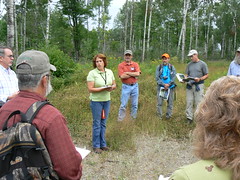 Minnesota DNR forest ecologist John Almendinger and forest soil scientist Dan Hanson held a hands-on field session in the Chippewa National Forest for forestry educators who convened at Itasca Community College in Grand Rapids for their annual conference. The group's focus is to improve the quality of two-year forestry programs at colleges and technician schools across the nation.
Minnesota DNR forest ecologist John Almendinger and forest soil scientist Dan Hanson held a hands-on field session in the Chippewa National Forest for forestry educators who convened at Itasca Community College in Grand Rapids for their annual conference. The group's focus is to improve the quality of two-year forestry programs at colleges and technician schools across the nation.
Itasca Community College was the host site for the 2008 Council of Eastern Forest Technician Schools (CEFTS) Conference. Educators from colleges offering two-year degree programs in forestry convened in Grand Rapids recently to compare educational methods and content, participate in forest tours led by area experts and visit the Forest History Center.
College instructors from nine states and New Brunswick, Canada, attended this year's conference, providing a diverse mix of forestry regions and educational institutions. Conference host Harry Hutchins, a natural resources instructor at ICC, was pleased at the conclusion of the week. "We did what we set out to do, which was to provide a selection of tours and sessions that would best represent this area," Hutchins stated. "Feedback from those who attended was very positive. Some even said it was the best conference they've ever attended. They got a good introduction to the ecologically based forestry in this region as well as a glimpse of our state's natural beauty." Hutchins was assisted by Brad Jones, his colleague at ICC who is also a natural resources instructor.
The conference began with an informal welcome reception with ICC Provost Mike Johnson, followed by the film "Minnesota, A History of the Land, Episode V: The Northern Forest," one in a series produced by the Bell Museum of Natural History, University of Minnesota and Twin Cities Public Television with major funding provided by the Blandin and Huss Foundations.
Day tours during the week included specialized segments in the Blandin Forest led by forest ecologist Cheryl Adams; Chippewa National Forest sessions with DNR forest ecologists Dan Hanson and John Almendinger and with U.S. Forest Service research technician Katie Lang; and a tour of the Cornish Hardwoods Forest with focus on SmartWood certification led by Aitkin County Land Commissioner Mark Jacobs. Each of the forest tours highlighted a specific aspect of forest ecology. Additionally, attendees were treated to an on-campus session with renowned forest ecologist John Zasada, an author and silviculturist specializing in items handcrafted from birch bark. The group also visited the Forest History Center, where they enjoyed tours of the logging camp and river wanigan, led by Ed Nelson, the Center's program director.
Most of the group arrived early for a two-day pre-conference trip to the Boundary Waters Canoe Area Wilderness, where they canoed to the famous Native American pictographs on Hegman Lake and later took part in specialized tours at the International Wolf Center in Ely, led by Vermilion Community College natural resources instructor Lori Schmidt.
"This is a group with a specific purpose and narrow focus," Hutchins explained. "These educators are responsible for teaching the foresters of tomorrow...those who will be tasked with caring for our country's natural resources in the future. That is not an easy job, especially given the challenges created by modern times. We were able to show them some of Northern Minnesota's most beautiful forests and introduce them to Minnesota's forest management philosophies and methods."
The conference was underwritten in large part by the Blandin Foundation's Vital Forests/Vital Communities initiative and Itasca Community College.





